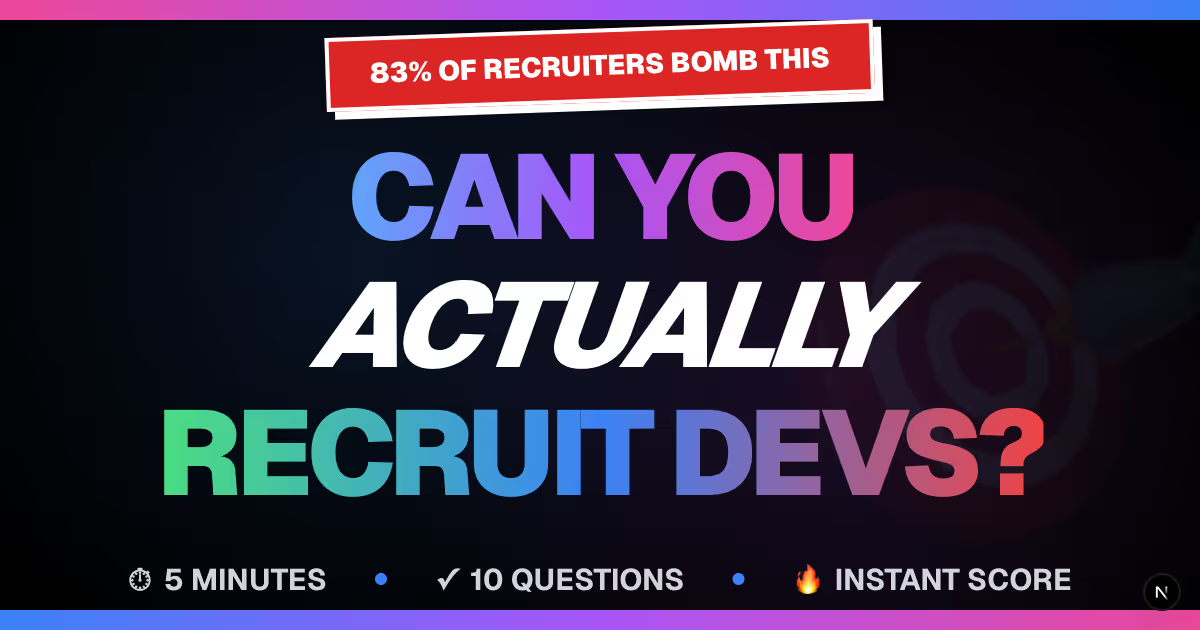


Learn how to craft effective recruiter emails that developers will actually read and respond to, boosting engagement and trust.
Recruiters often struggle to get responses from developers, with 90% of cold outreach emails being ignored. Why? Developers value trust, transparency, and relevance. This guide outlines 10 actionable tips to write emails that developers actually read and respond to - boosting reply rates to as high as 85–90%.
Key Takeaways:
- Subject Lines Matter: Be specific and relevant (e.g., "Senior React Developer Role - Remote, $140K–$160K").
- Personalize Messages: Reference the developer's work, skills, or career goals to show genuine interest.
- Keep It Brief: Use bullet points to highlight key details like role, salary, and location.
- Provide Context: Share technical challenges, growth opportunities, and work arrangements upfront.
- Respect Privacy: Use double opt-in introductions to ensure developers choose to engage.
By focusing on trust, clarity, and relevance, recruiters can transform their outreach into meaningful conversations. Let’s dive into the details.
How to write the BEST EMAILS to get Candidates NOW
1. Write Clear and Relevant Subject Lines
The subject line is your first - and often only - chance to grab a developer's attention. With inboxes flooded by recruiting emails daily, anything vague or generic is likely to be ignored.
To stand out, focus on being specific and relevant. A strong subject line immediately shows you understand the developer's expertise and interests. For example, instead of a generic "Exciting opportunity at tech startup", try something more precise like, "Senior React Developer role at a fintech startup - remote-first, GraphQL focus." Including details about the tech stack and work environment gives your message context and makes it more appealing.
Transparency is key when crafting subject lines for developers. A line like "Backend Python role at a healthcare AI company - $140K–$160K, fully remote" provides clarity about the technology, industry, pay range, and work setup. This helps developers quickly determine if the opportunity aligns with their skills and career goals.
Highlighting specific technical skills or projects can also make your message stand out. If you've noticed a developer's contributions to open-source projects or their expertise with a particular framework, mention it. For instance, "Kubernetes expert needed for DevOps role - noticed your work with the CNCF ecosystem" shows you’ve done your homework and aren't sending a mass email.
Finally, steer clear of clickbait phrases like "Life-changing opportunity!" or "You won't believe this role!" These come across as spammy and disrespectful of the developer's time. Instead, opt for clear, personalized communication that reflects professionalism and genuine interest.
Once you’ve nailed the subject line, make sure the email body builds on that strong introduction.
2. Personalize Every Message
Generic emails? They’re almost always ignored. Real personalization goes far beyond just slapping a name onto the greeting. It’s about showing you understand the recipient - their skills, interests, and career goals - and crafting a message that feels relevant to them.
Start by digging into the developer’s work. Check out their GitHub, recent projects, or open-source contributions. If you spot that they’ve been diving deep into React and TypeScript, call it out specifically. For instance, you could say, “I came across your TypeScript component library and was impressed by the way you prioritize type safety - it’s a standout approach.” This kind of detail shows you’ve taken the time to understand their expertise.
Tailor your outreach to align with where they’re headed. A developer shifting from frontend to full-stack work, for example, might be more open to roles that acknowledge and support this evolution. Shared connections or common interests can make your message even more personal. Maybe you both attended the same university, worked with similar tools, or are part of the same developer communities. These small but meaningful details help build trust and make your outreach feel genuine.
Why does this matter? Because personalized messages get better responses. Developers can spot a template email a mile away, and those tend to go straight to the trash. But when you show you understand not just what they do, but where they’re aiming to go, you’re no longer just another recruiter - you’re someone offering a real opportunity.
"Trust is the currency of modern recruiting" - Nimrod Kramer, October 2, 2025
By weaving this level of insight into your message, you turn what might have been dismissed as spam into a conversation worth having. Developers appreciate when someone takes the time to connect on a personal level, and in return, you’ll see far better engagement rates.
Next, we’ll dive into how to keep your emails short and to the point.
3. Keep Emails Short and Easy to Read
Developers juggle a lot of tasks, so they appreciate emails that get straight to the point. Your goal? Deliver your message in a way that's clear, quick, and to the point.
Think of your email as writing clean, efficient code: it should be easy to understand, immediately useful, and simple to scan. Stick to short paragraphs and use plenty of white space to make your message easy on the eyes.
Bullet points can be a lifesaver for breaking down key details like job requirements, perks, and next steps. For example:
- Position: Senior React Developer
- Location: Remote (US time zones)
- Compensation: $140K–$160K + equity
This format helps developers instantly gauge if the opportunity fits their needs. Emphasize the most critical details - like the company name or unique benefits - to grab attention. Developers often care about technical challenges, team culture, and personal growth, so make sure to touch on these areas.
Before hitting send, check how your email looks on a mobile device. A well-structured, easy-to-read email shows you value their time and helps build trust. Keeping it concise also sets the perfect tone for highlighting what makes your offer stand out.
4. Highlight Specific Value and Opportunities
Generic job descriptions can ruin great opportunities. Developers can easily spot vague, cookie-cutter outreach, and they tend to ignore it. Instead, focus on specific details that make your opportunity stand out.
Be clear about the technology stack and roadmap. Are they working with Go and Kubernetes to build microservices? Maybe they’re using Python and TensorFlow to implement machine learning features. Or perhaps they’re scaling a React Native app that serves millions of users. These specifics help developers quickly determine if the role aligns with their interests and career goals.
"Developers see full context upfront, so the ones who engage already know the role fits their expectations." - daily.dev Recruiter
Beyond the tech, emphasize what makes the role unique. Is your team practicing true continuous deployment with multiple releases per day? Do you offer developers dedicated time for open-source contributions or personal projects? Maybe your team is tackling interesting challenges, like optimizing database queries for billions of transactions or building real-time systems that demand zero downtime.
Be upfront about work arrangements. A remote-first culture, flexible hours, or the ability to work across time zones can be major draws. But don’t just say “flexible hours” - be specific. For instance, mentioning "10 AM–2 PM PT core hours with flexibility outside of that" gives developers a clear picture of what to expect.
"daily.dev Recruiter surfaces each role within the platform developers actively use where developers already come to explore with an open mind. With proprietary insight into their skills, passions, and career goals, we match jobs in ways that feel relevant to them." - daily.dev Recruiter
Also, highlight opportunities for career growth. Whether it’s working on greenfield projects, modernizing legacy systems, or optimizing high-performance metrics, these challenges often appeal more than perks like ping-pong tables or free snacks.
Providing enough context upfront allows developers to self-select based on genuine interest, rather than having to dig for basic information. When you're transparent about what makes the role special, you’ll attract candidates who are genuinely excited about the opportunity - not just those looking for any job.
5. Use a Friendly, Developer-Focused Tone
The tone of your email can shape a developer's first impression. Developers are often put off by overly formal corporate language or aggressive sales tactics that make them feel like just another number. What they value instead is clear, genuine communication that respects their expertise and time.
Ditch the corporate jargon and write as if you're talking to a colleague. For instance, instead of saying, "We are pleased to inform you of an exciting opportunity to leverage your skills", try something more personal like, "I noticed your work with React hooks and thought you might be interested in this frontend role." This kind of messaging shows you've done your homework and genuinely understand their background.
Accuracy is key when describing their technical experience. If someone has worked on Kubernetes orchestration, don't reduce it to vague terms like "container stuff." Similarly, if they’ve developed GraphQL APIs, avoid lumping it under a generic "backend development" label. Using precise terminology demonstrates respect for their skills and builds trust.
Steer clear of pressure tactics or over-the-top urgency. Phrases like "Act fast!" or "This opportunity won’t last long!" can feel spammy and off-putting. Instead, be transparent about timelines. A statement like, "We’re aiming to fill this role by mid-December", provides helpful context without feeling pushy.
Focus on their career goals, not just your hiring needs. Rather than saying, "We need someone with your skills", try, "This role could be a great next step for someone looking to scale distributed systems at an enterprise level." This approach emphasizes how the opportunity aligns with their professional growth.
A friendly, developer-focused tone doesn’t mean being overly casual - it’s about striking a balance between professionalism and authenticity. Up next, we’ll explore how to create warm, double opt-in introductions.
6. Offer Warm, Double Opt-In Introductions
A warm, double opt-in introduction ensures both parties agree to connect before any outreach happens. This method removes any sense of spam because the developer has already reviewed the opportunity and chosen to engage.
Here’s how it works: developers are presented with your role in a trusted environment, given all the details, and then decide if they want to proceed. When you follow up, you're connecting with someone who has already expressed interest - someone who feels the role aligns with their career goals and expectations.
This approach leads to high engagement rates, with reply rates often exceeding 85–90%. Why? Because you're only reaching out to developers who have actively opted in. This builds immediate trust and credibility. Even more compelling, 90% of the daily.dev network won’t respond on other platforms but will engage when introduced through a trusted channel.
"Every intro comes from a developer who reviewed your role and chose to engage - not someone you had to chase." - daily.dev Recruiter
daily.dev Recruiter is a great example of this process in action. Job opportunities are seamlessly integrated into the daily.dev platform, where developers already spend time learning and interacting. Roles are shown discreetly to those who match specific skills and career goals, with full context provided upfront, so developers can make informed decisions about whether to opt in.
"Every introduction is double opt-in, which means the developer has already reviewed the role and agreed to the conversation." - daily.dev Recruiter
This system prioritizes a developer-first approach by giving candidates control over their opportunities while ensuring you only engage with those genuinely interested. Forget sending dozens of personalized emails that go unanswered. Instead, you’ll have meaningful conversations with pre-qualified candidates who are ready to discuss their next career step.
To make this method work, focus on sharing comprehensive role details upfront. The more context you provide, the more informed and qualified your conversations will be. Transparency is key - it builds trust and sets the stage for productive discussions. Finally, use clear, low-pressure calls to action to further establish trust and encourage engagement.
sbb-itb-d1e6221
7. Provide Clear, Low-Pressure Calls to Action
When it comes to reaching out to developers, the tone of your call to action (CTA) can make or break your approach. Pushy or overly assertive language can come across as spammy, while a more inviting and conversational tone fosters genuine engagement. The goal is to ensure developers feel entirely in control of their next steps.
Instead of saying something like, "Please respond by Friday", opt for softer, more open-ended phrases such as, "Would you be interested in learning more about this opportunity?" or "If this sounds intriguing, I'd love to share additional details." These approaches feel less like demands and more like an invitation to a conversation.
Respecting developers’ time is crucial. Phrases like "Happy to answer any questions" demonstrate that you value their schedule and decision-making process. This complements earlier personalization efforts, reinforcing a respectful and professional tone.
Context also plays a significant role in crafting your CTA. For example, if you're reaching out on a platform where the developer has already expressed interest in similar roles, a direct but friendly message could work well: "Since you've shown interest in this type of role, would you like to schedule a brief chat to discuss the details?"
Avoid creating urgency with artificial deadlines, which can feel disingenuous. Instead, be transparent: "We're looking to fill this role within the next month." This honesty respects their autonomy and helps build trust.
Developer-focused platforms have shown that this approach fosters better engagement. When developers connect through systems where they've already reviewed opportunities and opted in for conversations, the interaction feels more collaborative and less transactional.
"Trust is the currency of modern recruiting" - Nimrod Kramer, daily.dev
Ultimately, your CTA should feel like the beginning of a partnership rather than a sales pitch. Position yourself as a collaborator in their career journey with language like: "I'd be happy to share more about the team and technical challenges if you're interested in exploring further."
Let your enthusiasm shine through in an authentic and pressure-free way. Transparency and respect not only build trust but also set the stage for a meaningful and productive conversation.
8. Send at Optimal Times for Developers
When it comes to engaging developers, timing is everything. Reaching them during their most active hours can dramatically increase the chances of your email being noticed and acted upon.
Developers often begin their day by catching up on industry news and tools. Sending emails during these periods of activity can significantly boost visibility. Platforms like daily.dev, which logs an impressive 1 billion developer sessions, show how ingrained these routines are. Developers who engage on their own time tend to respond more effectively, with reply rates soaring to 85–90%. This daily rhythm is a key factor to consider when planning your outreach.
"Hire where developers start their day, every day" - daily.dev Recruiter
Once you identify the best times to send, take it a step further by testing and refining your schedule. Pair your carefully crafted, personalized messages with strategic timing. Keep an eye on open rates and response patterns to fine-tune your approach. The right timing doesn’t just complement personalization - it strengthens the overall impact of your message.
9. Ensure Deliverability and Professional Sender Identity
Making sure your email gets to a developer's inbox starts with sender credibility and avoiding spam triggers. In developer-first recruiting, having a professional sender identity is key because it builds trust through personalized and respectful communication.
One way to sidestep the pitfalls of cold outreach is by focusing on sender credibility and using warm, double opt-in introductions. These methods ensure your email reaches developers who are genuinely interested in hearing from you.
"Most platforms give you a database of profiles. With daily.dev, you get warm, double opt-in introductions from developers already engaged on our platform. It's a distribution channel powered by developer attention, not another search tool." - daily.dev Recruiter
A strong sender identity also plays a vital role in making sure your outreach is effective. Connecting with developers through trusted platforms naturally avoids deliverability issues. This strategy not only keeps your sender identity clean but also nurtures authentic and welcomed connections.
Timing your outreach for when developers are most active on trusted channels can further boost engagement. As one recruiter aptly puts it: > "No outreach required. Ever." - daily.dev Recruiter
10. Respect Privacy and Communication Preferences
Building trust with developers starts with respecting their privacy and communication preferences. This means emphasizing consent and transparency from the very first interaction.
Rather than sending unsolicited messages, aim for double opt-in introductions - a method where developers actively choose to engage with opportunities. This mutual respect sets a positive tone for the relationship. In fact, early data suggests that reply rates for this approach can reach an impressive 85–90%.
Being upfront and honest is key. Avoid vague job descriptions or omitting important details. Instead, provide clear and complete information about the role so developers can make informed decisions about whether it aligns with their career goals. Additionally, offer opportunities through platforms developers trust, rather than bombarding them with follow-ups. This approach reflects a developer-first mindset and reinforces trust.
Developers consistently show a preference for respectful, consent-driven communication. The contrast between this method and traditional outreach methods is striking, highlighting the importance of using trusted, developer-centric platforms.
"No outreach required. Ever." – daily.dev Recruiter
Comparison Table
Here’s a breakdown of how spammy recruiter emails stack up against non-spammy ones:
| Practice | Spammy Approach | Non-Spammy Approach |
|---|---|---|
| Personalization | Generic mass emails | Messages crafted around a developer’s unique skills and interests |
| Introduction Method | Cold outreach that disrupts developers' workflows | Warm, double opt-in introductions that let developers choose to engage |
| Developer Trust | Low trust due to impersonal and intrusive tactics | High trust nurtured through respectful, platform-native communication |
| Reply Rates | Low response rates | High response rates |
This comparison highlights the importance of personalized, double opt-in outreach in earning developers' trust. Unlike traditional cold emails that interrupt and alienate, warm introductions empower developers to engage on their own terms. Thoughtful, relevant communication is the foundation for rebuilding trust in the recruiting process.
Conclusion
The shift from spam-heavy cold outreach to trust-focused recruiting is now a must in the developer hiring world. As Nimrod Kramer aptly states, "Recruiting is broken because it burned trust". The ten strategies outlined in this article underscore a key takeaway: developers engage when they feel respected and valued, not when they're reduced to numbers in a system.
Successful recruiters take the time to tailor their messages, matching opportunities to the unique skills and career aspirations of developers. This approach has consistently driven reply rates to impressive levels of 85–90%.
A striking example comes from the daily.dev network, where 90% of members interact in spaces where they feel comfortable and understood. This demonstrates that genuine, trust-based relationships can turn recruiting into something far more meaningful than a numbers game. Platforms like daily.dev Recruiter show how prioritizing authentic connections can reshape the entire process.
By respecting developers' preferences and focusing on their choices, recruiters not only improve response rates but also rebuild trust in the industry. As Kramer puts it, "Trust is the currency of modern recruiting".
The path forward is clear: prioritize meaningful interactions. Share full context, honor communication preferences, and use trusted platforms to craft messages that resonate and nurture long-term trust.
FAQs
What’s the best way for recruiters to grab a developer’s attention with an email?
Recruiters aiming to grab a developer's attention should prioritize crafting personalized, value-packed emails that align with the developer's interests and respect their time. Tools like daily.dev Recruiter simplify this process by enabling warm, double opt-in introductions with developers who are already engaged and receptive to suitable opportunities. This trust-centered method ensures your message comes across as genuine and avoids the pitfalls of being dismissed as spam.
How can recruiters write personalized emails that developers will actually respond to?
To craft recruiter emails that developers are more likely to respond to, focus on personalization and clear value. Start by mentioning something specific about the developer - this could be a recent project, a unique skill, or a contribution they've made. Steer clear of generic phrases or overly formal tones; developers tend to value authenticity over polished corporate language.
Keep your message short and to the point. Clearly explain why you're reaching out and how the opportunity you're offering aligns with their interests or career goals. Share a bit about your company or the role to provide context. Wrap things up with a friendly call-to-action, like inviting them to chat or learn more, instead of pushing for an immediate decision.
For an even better response rate, you might explore platforms like daily.dev Recruiter. These tools connect you with developers who are already engaged and open to hearing about relevant opportunities, making your outreach feel more intentional and less like a cold email.
What is a double opt-in introduction in developer recruiting, and why does it boost engagement?
In developer recruiting, a double opt-in introduction means both the recruiter and the developer consent to connect before any conversation begins. This ensures that developers have genuine interest in the opportunity and have taken the time to review the role in advance.
This method fosters trust and cuts through the clutter of unsolicited outreach. Developers appreciate the respect for their time, while recruiters engage only with candidates who are prepared and interested. The result? A smoother, more effective hiring process for everyone involved.
Related Blog Posts








